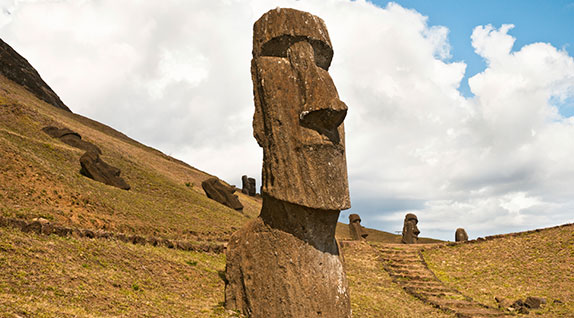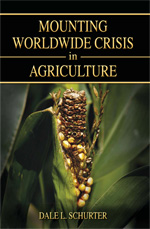 Thinkstock
Thinkstock
Article
The fate of the small Polynesian island stands as a stark reminder of the outcome that can result when wrong choices are made.
Learn the why behind the headlines.
Subscribe to the Real Truth for FREE news and analysis.
Subscribe NowThe cold faces of stone stare silently over the barren landscape. Standing at attention, each stoic face resembles the one beside it. On a tiny Polynesian island in the eastern Pacific Ocean, these sentinels are the only immediately recognizable sign of life.
This is Easter Island.
A closer inspection reveals abandoned villages, gigantic stone quarries, and hundreds of platforms used for religious rites—all built by a once-thriving society.
Throughout a 600-yard quarry known as Rano Raraku, stone picks, chisels and axes lie in dusty disarray. Situated on a dormant volcano, the quarry provided material for Moai, the giant stone statues that dot the island. The only human presence in the mine is a crushed finger bone trapped under a toppled Moai, perhaps remnants of a miner’s accident.
Many of the Moai remain unfinished, partially carved and frozen in time. Finely chiseled features adorn some groups; others are without defined shape, ranging from 13 to 75 feet tall. The stone army grimly stands watch at the abandoned mines and gapes at deserted scars in the earth.
Just east of the quarry lie vast stretches of fields, flat, brown and scorched. Dried hay forms a thin veneer over layers of volcanic rock. Sandy soil, drained of all nutrients, no longer supports even small shrubs and trees.
The flat terrain offers little resistance to strong winds sweeping the plains. The few remaining trees are no taller than 10 feet and offer little protection for indigenous animals. Only a handful of islanders remain there.
Without firsthand descriptions of historical events, scientists have relied on pollen samples, archeological digs, and geological tests to understand what happened to the ecosystem. While various theories abound, Easter Island is hailed as one of the most haunting cases of environmental collapse ever seen. It serves as an isolated eco-survival study of mankind’s “worst-case scenario”—a possible testament to destruction on a grand scale.
Early Easter Island
Situated off the coast of Chile, Easter Island was presumably once a lushly forested subtropical paradise. The tiny triangular nation supported a society of up to 30,000 people. Separated from the rest of the world by roughly 1,300 miles of Pacific Ocean, the early Polynesian inhabitants most likely migrated from the neighboring Pitcairn Islands and the mainland of South America.
The climate was well-suited for habitation; three long-dormant volcanoes left rich deposits of fertile soil across the terrain. Open grasslands covered the island in between Easter Palm forests, which grew to over 70 feet tall. The volcanic deposit at Rano Raraku to the southeast provided plentiful stores of volcanic tuff for construction.
Tribes that migrated to the island formed a loose collective government that created a unique culture. These groups, which relied primarily on farming and seafaring, had a structured tribal society, with a leading chief and a class of priests, along with farmers and tradesmen. The religious pantheon included hundreds of animalistic gods.
Chiefs raised the Moai, each weighing an average of 10 tons, to prove their status with the gods, and exercise power over their followers. The chiefs’ elite status allowed a ruling class to run society and maintain order among tribes.
Under chiefs, vast projects were organized. Trading harvested resources from the 66-square-mile island encouraged construction on a broad scale. Large plantations produced food surpluses, which aided population growth. Religious worship, fueled by ever larger Moai and elaborate funeral services, united the tribes.
For a time, the society blossomed in an era of prosperity and peace.
Unknown Reason
After several generations, though, available resources began to be consumed. Forests were cut down to be used for canoes, ropes and firewood. Farms producing sweet potatoes, taro and sugarcane stripped soils of available nutrients. Bird, fish and porpoise populations dwindled to extinction.
A massive migration was impossible due to the great distance from the nearest landmass. The isolated island was unable to draw needed resources from other continents and was forced to continue on its own.
The arrival of Europeans did not help the situation as they brought diseases such as syphilis and smallpox, as well as rats that may have decimated millions of trees. The Europeans may have also forced some inhabitants into slavery—leaving the island even more vulnerable.
The population soon began to die out. Easter Island descended into civil war as chiefs-turned-warlords vied for leftover resources.
Internal conflict and violence turned into anarchy. The island was no longer unified and cooperation between peoples ceased. Any attempt to find an organized solution to catastrophic problems was nullified.
Great amounts of forest had been cut for materials to erect the gigantic Moai. While scientists today do not fully understand how these ancient people raised the monoliths, they agree that strong lumber and ropes were necessary.
Instead of planning for the future, chiefs squabbled over who could erect the largest Moai. In their lust for power, they sought to maintain their god-like statuses with great feats of architecture and dazzling sacrificial pyres.
The population slowly overextended itself and 90 percent of all plant and animal life on the island became extinct. By the time the people realized what was occurring, it was too late.
Picture of Earth?
Many today see Easter Island as a metaphor of the modern world. With haunting and obvious parallels, Earth is a tiny island floating in the vastness of space. Globalization, trade and communication have united various “tribes” on our “island.” With “tribes” of nations bound together in a global network, humanity is responsible for planning, controlling and using its valuable—and limited—resources.
Yet Easter Island is not the only example to have a hand in its own destruction. The early civilization of Sumer in Mesopotamia is another clear example of agricultural breakdown. Many archaeologists point to aggressive irrigation tactics (leading to salinization of the soil) as a major cause for the fall of this empire. Even today, the area remains desolate!
Misuse of resources also contributed to the demise of the Roman Empire.
In A Short History of Progress, Ronald Wright demonstrated the truth of the anonymous quote, “Each time history repeats itself, the price goes up.”
He wrote: “The collapse of the first civilization on earth, the Sumerian, affected only half a million people. The fall of Rome affected tens of millions. If ours were to fail, it would, of course, bring catastrophe on billions.”
Easter Island, Sumer and Rome all stand as a stark reminder for Earth’s inhabitants—a testament to mankind’s inability to solve its problems and a historical example of Proverbs 29: “Where there is no vision, the people perish” (vs. 18).
More on Related Topics:
- What to Know About the Devastation from the Los Angeles-area Fires
- Los Angeles Wildfires Rage Out of Control, Testing Firefighting Resources
- A Quarter of Freshwater Animals Are Threatened with Extinction, New Research Shows
- After 20 Years, Indonesia’s Post-Tsunami Generation Stays Vigilant for Future Disasters
- India’s Capital Chokes as Air Pollution Levels Hit 50 Times the Safe Limit



